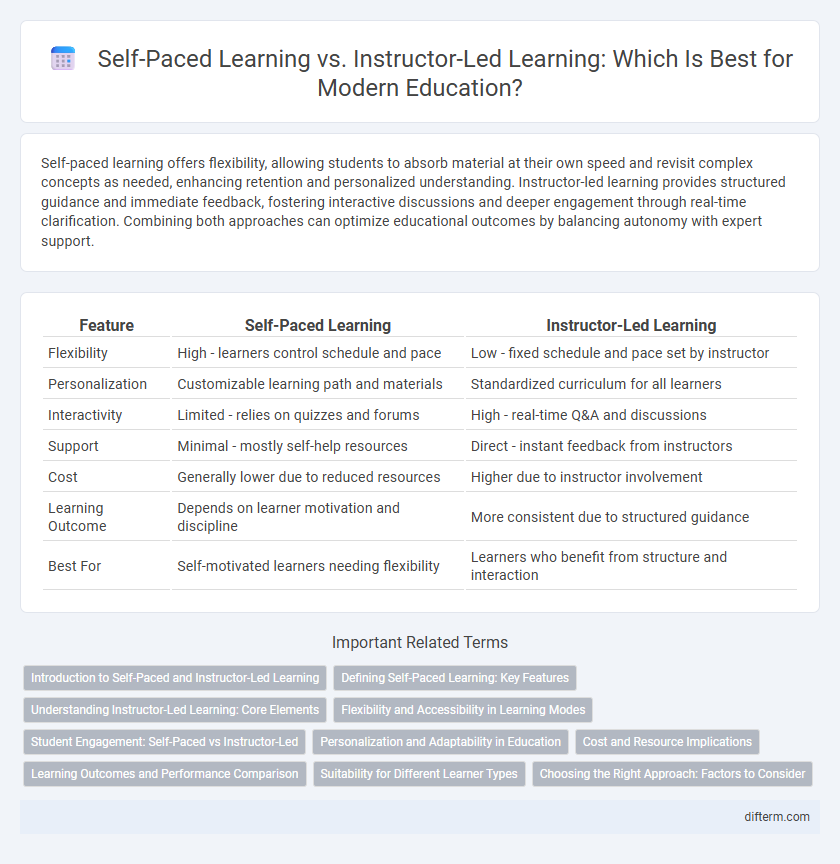Self-paced learning offers flexibility, allowing students to absorb material at their own speed and revisit complex concepts as needed, enhancing retention and personalized understanding. Instructor-led learning provides structured guidance and immediate feedback, fostering interactive discussions and deeper engagement through real-time clarification. Combining both approaches can optimize educational outcomes by balancing autonomy with expert support.
Table of Comparison
| Feature | Self-Paced Learning | Instructor-Led Learning |
|---|---|---|
| Flexibility | High - learners control schedule and pace | Low - fixed schedule and pace set by instructor |
| Personalization | Customizable learning path and materials | Standardized curriculum for all learners |
| Interactivity | Limited - relies on quizzes and forums | High - real-time Q&A and discussions |
| Support | Minimal - mostly self-help resources | Direct - instant feedback from instructors |
| Cost | Generally lower due to reduced resources | Higher due to instructor involvement |
| Learning Outcome | Depends on learner motivation and discipline | More consistent due to structured guidance |
| Best For | Self-motivated learners needing flexibility | Learners who benefit from structure and interaction |
Introduction to Self-Paced and Instructor-Led Learning
Self-paced learning allows students to progress through educational material at their own speed, enhancing flexibility and personalization in skill acquisition. Instructor-led learning provides structured guidance and real-time interaction, which supports immediate feedback and collaborative engagement. Both approaches cater to different learning styles and goals, optimizing educational outcomes through varying degrees of autonomy and support.
Defining Self-Paced Learning: Key Features
Self-paced learning allows learners to progress through educational content at their own speed, accommodating individual schedules and learning preferences. Key features include flexible access to materials, personalized pacing, and the ability to revisit content multiple times for better comprehension. This method leverages digital platforms and multimedia resources to enhance engagement and knowledge retention without the constraints of fixed class times.
Understanding Instructor-Led Learning: Core Elements
Instructor-led learning centers around real-time interaction, structured schedules, and guided facilitation by educators to enhance comprehension and engagement. Key elements include direct feedback, collaborative discussions, and adaptive instruction tailored to learners' needs. These components foster accountability and immediate clarification, often leading to deeper understanding compared to self-paced formats.
Flexibility and Accessibility in Learning Modes
Self-paced learning offers unparalleled flexibility by allowing students to access course materials anytime and progress at their own speed, accommodating diverse schedules and learning preferences. Instructor-led learning provides structured schedules and real-time interaction, which can support engagement but may limit accessibility for learners with time constraints. The combination of digital platforms and mobile technology enhances the accessibility of self-paced learning, making education more inclusive and adaptable to individual needs.
Student Engagement: Self-Paced vs Instructor-Led
Self-paced learning fosters student engagement by allowing learners to control their study pace and revisit materials, enhancing comprehension and retention. Instructor-led learning increases engagement through real-time interaction, immediate feedback, and structured activities that promote collaboration. Balancing both methods can optimize engagement by combining flexibility with guided support.
Personalization and Adaptability in Education
Self-paced learning enables personalized education by allowing students to progress according to their individual pace and learning style, enhancing adaptability to diverse needs. Instructor-led learning, while structured, offers real-time feedback and tailored guidance, accommodating immediate adjustments based on student performance. Both approaches contribute uniquely to personalized and adaptable education environments, optimizing learner engagement and outcomes.
Cost and Resource Implications
Self-paced learning significantly reduces costs by minimizing the need for physical infrastructure and allowing learners to access materials anytime, which lowers overall resource consumption. Instructor-led learning often requires substantial investment in skilled educators, scheduling coordination, and classroom resources, increasing operational expenses. Organizations prioritizing scalability and budget efficiency frequently prefer self-paced models to optimize resource allocation while maintaining educational quality.
Learning Outcomes and Performance Comparison
Self-paced learning enables learners to absorb material at their own speed, often resulting in higher retention and personalized skill mastery compared to instructor-led formats. Studies reveal that self-paced learners exhibit a 20-30% improvement in knowledge retention and application in real-world scenarios. Instructor-led learning, while offering structured guidance and immediate feedback, sometimes limits learner autonomy, which can affect long-term performance outcomes negatively.
Suitability for Different Learner Types
Self-paced learning offers flexibility and customization ideal for independent learners who thrive on setting their own schedules and progressing at their own pace. Instructor-led learning suits individuals who benefit from real-time interaction, immediate feedback, and structured guidance provided by educators in classroom or virtual settings. Learners with strong self-motivation excel in self-paced environments, while those needing accountability and direct support perform better with instructor-led formats.
Choosing the Right Approach: Factors to Consider
Choosing the right learning approach depends on individual goals, learning styles, and available resources, with self-paced learning offering flexibility and personalized progress tracking. Instructor-led learning provides structured guidance, immediate feedback, and interactive engagement, which can enhance motivation and comprehension. Consider factors such as time constraints, need for real-time support, and the complexity of the subject matter when deciding between self-paced and instructor-led formats.
self-paced learning vs instructor-led learning Infographic

 difterm.com
difterm.com